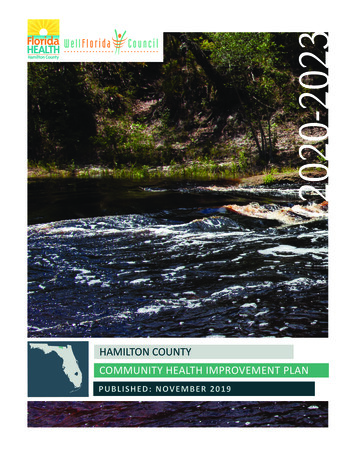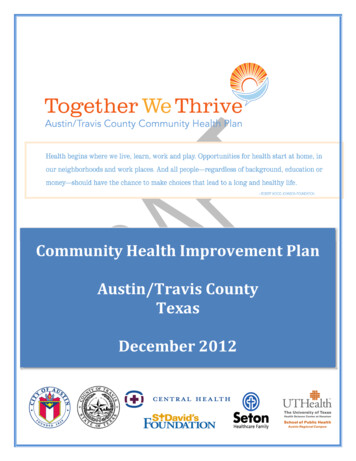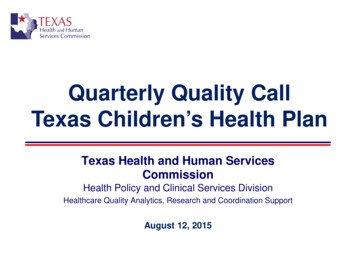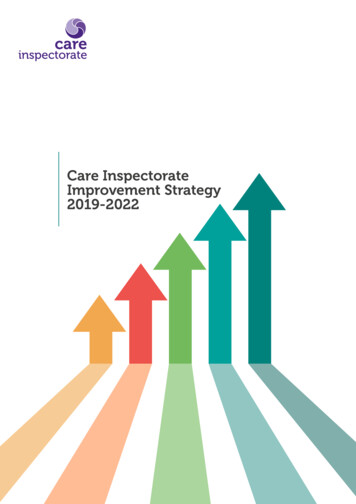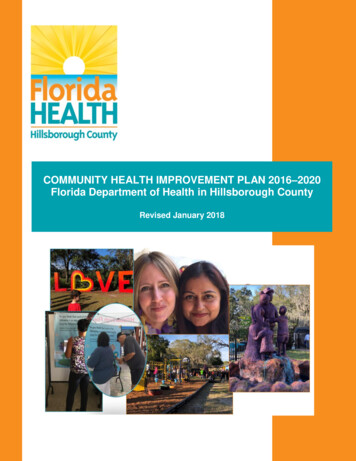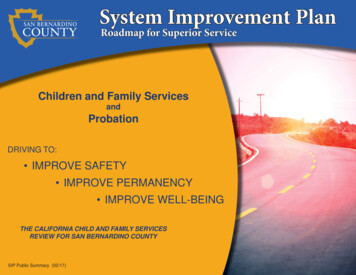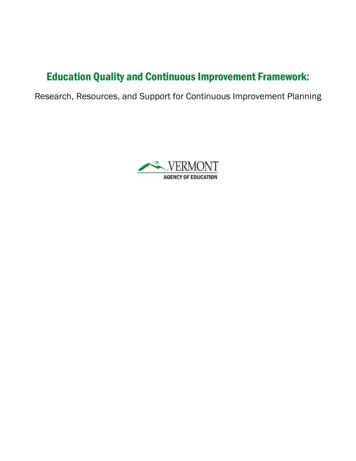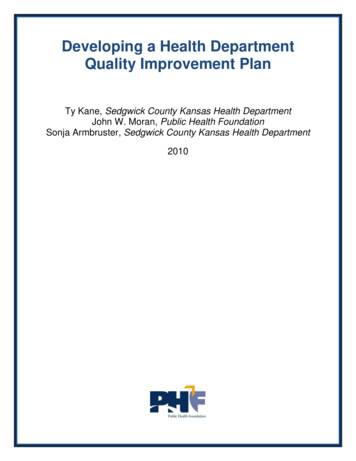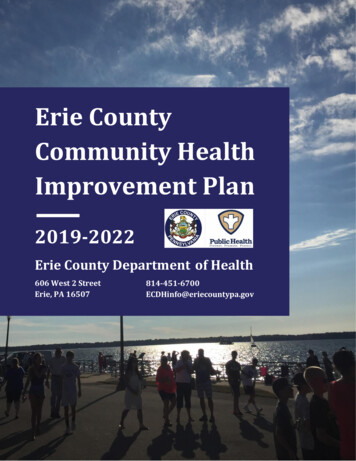
Transcription
Erie CountyCommunity HealthImprovement Plan2019-2022Erie County Department of Health606 West 2 StreetErie, PA 16507814-451-6700ECDHinfo@eriecountypa.gov0
1Table of ContentsTABLE OF CONENTS1EXECUTIVE SUMMARYImproving Health in Erie County2BACKGROUNDPublic Health Department Accreditation4Public Health 3.04Social Determinants of Health5Blueprint6Development Process8Partnerships and Implementation9Evaluation10COMMUNITY PRIORITIES AND STRATEGIESLifestyle Behavior Change11Disease Prevention, Early Detection, Control15Mental Health and Quality of Life19ACRONYMS AND TECHNICAL NOTES23ACKNOWLEDGMENTS24For more information on the Community Health Improvement Plan, please contact Sarah Morgan atthe Erie County Department of Health at ECDHinfo@eriecountypa.gov or 814-451-6700Cover Photo by Lillian Pertlhttps://eriecountypa.gov/departments/health
2Executive SummaryImproving Health in Erie CountyThis Community Health Improvement Plan (CHIP) is designed to engage andmobilize all organizations and sectors to improve the health and wellness of Erie Countyresidents. The Erie County Department of Health (ECDH) has adopted the PublicHealth 3.0 model. This model focuses on strong partnerships with communityorganizations as well as non-traditional partners. Through this model, the ECDH servesas the chief health strategist for Erie County, making it responsible for assessing thecommunity’s health, identifying priorities, and coordinating improvement efforts. TheCommunity Health Needs Assessment (CHNA) and the CHIP serve as a guide for ErieCounty organizations and entities to work together to improve the health of ourcommunity.The Erie County Department of Health utilized the concepts and stages of theMobilizing for Action through Planning and Partnerships (MAPP) model to develop theCHNA and CHIP. Through the assessment, strategic issues were prioritized to create acommunity health blueprint. This document identifies goals, objectives, and strategiesto improve the community health priorities, with high-level goals listed below.Community Priority 1: Lifestyle Behavior ChangeThis priority includes Nutrition, Physician Inactivity, Tobacco, Alcohol andOther Substance Use DisordersGoal 1: By 2022, decrease preventable chronic disease by improving theability of residents to make healthy lifestyle behavior changes by ensuringadequate knowledge, access and opportunity to achieve a healthy lifestyle.Community Priority 2: Disease Prevention, Early Detection, ControlThis priority includes Obesity, Cardiovascular Disease, Diabetes and PreDiabetes, COPD, and Cancer: Lung, Breast, Prostate, and ColorectalGoal 2: By 2022, decrease preventable chronic disease by improving accessto screenings and th
3Community Priority 3: Mental Health and Quality of LifeThis priority includes Depression, Suicide, Poor Mental Health, PoorPhysical Health, and Health LiteracyGoal 3: By 2022, reduce the burden of mental health disorders and ensureresidents have the knowledge and opportunity to improve their quality oflife.The CHNA outlines several recurring themes and overarching challenges, whichrelate to social determinants of health. Through a series of focus groups, a thematicperception was discovered that many of the overarching challenges were attributed to alack of adequate financial resources either to enable more services or to utilize services.Respondents attributed good health and overall success to education and the ability toutilize education to earn a family sustaining wage. These perceptions were carefullyconsidered when developing the strategies in this plan.The success of this plan is dependent on the collaboration of many cross-sectororganizations in Erie County. The ECDH will serve as the chief health strategist forimplementation of this plan. Local hospitals, mental health providers, behavioral healthproviders, government entities, allied health providers, community organizations, andbusinesses all play a vital role in the health of Erie County. This is a cyclical process ofassessment, planning, implementation, and evaluation. As emerging health needs areidentified, the ECDH will identify data sources and indicators so that these health needsmay be included in the next CHNA. This process ensures that Erie County’s publichealth system will become adaptable enough to address emerging health needs on aproactive basis.This plan would not have been possible without the knowledge, support, andcontributions from our many partners listed in the Acknowledgements h
4BackgroundPublic Health Department AccreditationErie County Department of Health was the first health department inPennsylvania to achieve national accreditation from the Public Health AccreditationBoard (PHAB.) PHAB recognizes health departments’ commitment to qualityimprovement, performance management, accountability, transparency, and the capacityto deliver the Ten Essential Public Health Services. Nationally accredited healthdepartments are dedicated to achieving the highest standards of public health practice.This relationship is cultivated through strong personalized community partnerships.PHAB holds tribal, state, local and territorial public health departments to a higherstandard to ensure quality improvement, strong community commitment, andaccountability, which ultimately results in a healthier and happier community.Public Health 3.0Through the accreditation process, the department has evolved and identified theneed to pursue the Public Health 3.0 model. This model focuses on improving publichealth infrastructure to better impact 21st century public health needs. This is achievedthrough five themes: strong leadership and workforce; strategic partnerships; flexibleand sustainable funding; timely and locally relevant data, metrics, and analytics; andfoundational infrastructure. Through this model, a public health department isrecognized as the chief health strategist in a community. As the chief health strategist,the health department is responsible for assessing the community’s health, identifyingpriorities, and coordinating improvement efforts to improve social determinants ofhealth. The Community Health Needs Assessment and the Community HealthImprovement Plan will serve as a guide for Erie County organizations and entities towork together to improve health within the lth
5Social Determinants of HealthSocial determinants of health are the conditions in which people are born, grow,live, work and age, that ultimately have an impact on personal health. Although peoplehave some control over their environment, actions, and what they consume, a largeportion of health outcomes are determined by circumstances that are difficult to modify.The Community Health Needs Assessment outlined several overarchingchallenges related to social determinants of health specific to Erie County. Thesechallenges are outlined in the Erie County Community Health Blueprint. Through aseries of focus groups, it was discovered that respondents felt many of the overarchingchallenges were attributed to a lack of adequate financial resources either to enablemore services or to utilize services. Respondents attributed good health and overallsuccess to education and the ability to utilize education to earn a family sustainingwage.In order to effectively impact community health, it is important to address socialdeterminants of health, which is also referred to as an “up-stream” approach. Byaddressing “up-stream” social determinants of health, such as poverty, a greaterpopulation is impacted preventatively rather than reacting to chronic disease and otherhealth issues later in life. In developing strategies to address community healthpriorities, special consideration was given to social determinants of health. A visualrepresentation of upstream approaches to impact social determinants of health may befound in Figure 1.https://eriecountypa.gov/departments/health
6Figure 1: Social Determinants of Healthde Beaumont Foundation and Trust for America’s Health (2019)BlueprintUtilizing the MAPP model, a Community Health Blueprint was developed toillustrate strategic issues related to community health priorities, target populations, andoverarching challenges. This blueprint may be found in Figure 2.https://eriecountypa.gov/departments/health
7Figure 2: Community Health th
8Development ProcessA Community Health Improvement Plan (CHIP,) is a strategic plan that reviewsprimary health issues identified in the Community Health Needs Assessment (CHNA)and develops an action plan that demonstrates how these improvements to communityhealth will be accomplished. In 2018, a CHNA was completed for Erie County, whichmay be found at ecdh.org. Community partners and stakeholders formed a collaborativecommittee to more accurately identify and prioritize strategic issues.The Erie County Department ofFigure 3: MAPP ProcessHealth utilized the concepts and stagesof the Mobilizing for Action throughPlanning and Partnerships (MAPP)model to develop the CommunityHealth Needs Assessment andCommunity Health Improvement Plan.A graphic representation of the MAPPmodel may be found in Figure 3.MAPP relies on four assessments toprovide the information needed todevelop strategic issues, goals,strategies, and action plans for thecommunity. These assessments are: (1)Community Health Status Assessment,which provides quantitative andqualitative data about the health needs of residents; (2) Community Themes andStrengths Assessment, which identifies issues and topics of interest to the community;(3) Forces of Change Assessment, which identifies current or future issues that mayaffect the community or public health system; and (4) Local Public Health SystemAssessment, which identifies organizations that contribute to the public’s health. Theseassessments may be found in the Community Health Needs Assessment located atecdh.org.Prioritization techniques provide a structured approach that strives to be unbiased,in order to analyze health problems and identify areas of concern within the community.The CHNA committee used a prioritization matrix for this process. It is a common toolused when health problems are evaluated against a number of criteria because ithttps://eriecountypa.gov/departments/health
9provides the ability to assign varying degrees of importance or weights to these criteria.The matrix is based upon the following six criteria: (1) magnitude of the problem, (2)seriousness of the problem, (3) variance against benchmarks, (4) feasibility and ease ofimplementation, (5) impact on other health outcomes, and (6) availability of communityresources.Prioritization is a key component of the MAPP process and drives theCHIP so that it is an accurate representation of the community’s truehealth improvement needs.Community health priorities were utilized as the basis for developing the goalsand objectives of this plan. A literature review of improvement plans from keystakeholders was completed to assess current improvement efforts and identify gaps.This plan was created with the intent of providing a framework and opportunities for allsectors to participate in and improve the public health system in Erie County.Partnerships and ImplementationThe success of this plan is dependent on the collaboration of multipleorganizations across several sectors. The Erie County Department of Health will serveas the chief health strategist for implementation of this plan. Local hospitals (UPMCHamot, St. Vincent, Millcreek Community, and Corry Memorial,) mental healthproviders, behavioral health providers, government entities (county, city, andmunicipal,) allied health providers, community organizations, and businesses all play avital role in the health of Erie County. The Corry Blue Zones Project is closely alignedwith Corry Memorial Hospital’s plan and has been launched as a pilot project that, ifsuccessful, will be expanded to include additional Erie County municipalities.In many cases, additional partner organizations may be established as the planmoves forward per the needs of the community, expanding the scope of this plan. Asthe plan is implemented, the Erie County Department of Health and partnerorganizations will continue to monitor the changing needs of the community andsupport efforts to impact health so all Erie County residents have equitable opportunityto achieve optimum health. As emerging health needs are identified, the Erie CountyDepartment of Health will begin to identify data sources and indicators so that thesehealth needs may be included in the next Community Health Needs alth
10EvaluationThis plan is designed to provide a roadmap for the community to improve itsgreatest health needs and monitor emerging health needs. In order to achieve the goalsidentified in this plan, the Erie County Department of Health will develop an annualreport, which will include updates on outcome indicators, as well as identification ofpotential emerging health issues. Stakeholders will be informed of the report’s releaseand asked for input regarding revisions to goals, objectives, outcome indicators, andstrategies. Stakeholders will also have an opportunity to comment and provide feedbackon emerging health issues that should be prioritized in the upcoming Community HealthNeeds Assessment, which will inform content of future Community HealthImprovement Plans.https://eriecountypa.gov/departments/health
11Community Priorities and StrategiesCommunity Priority 1:Lifestyle Behavior ChangeGoal 1:By 2022, decrease preventable chronic disease by improving the ability of residents tomake healthy lifestyle behavior changes by ensuring adequate knowledge, access andopportunity to achieve a healthy lifestyle.OBJECTIVE 1.1: BY 2022, INCREASE KNOWLEDGE A ND OPPORTUNITIESFOR ALL ERIE COUNTY RESIDENTS TO ACCESS AND CONSUMEHEALTHY FOODS AND PH YSICAL ACTIVITIES.OutcomeIndicatorPercent ofErieCountyresidentswhoconsumehealthyfoods andparticipatein HS12% of Erie County adultsreport consuming fruits andvegetables five or more timesper day14% of Erie County adultsreport consuming five or moreservings of fruits andvegetables per day6% of Erie County adults aged65 and above report consumingfruits and vegetables five ormore times per day7% of Erie County adults aged65 and above report consumingfruits and vegetables five ormore times per dayECHS23% of Erie County adultsreported having no leisure timephysical activity in the pastmonth20% of Erie County adultsreported having no leisure timephysical activity in the pastmonthECHS34% of Erie County adults whoearned less than 15,000 peryear reported having no leisuretime physical activity in thepast month31% of Erie County adults whoearned less than 15,000 peryear reported having no leisuretime physical activity in thepast th
12SHORT-TERM STRATEGIES :1.1.11.1.21.1.3Implement Fruit and Vegetable Prescription Program as a medicalintervention for patients at risk of nutrition-related chronic diseases throughErie County Department of Health and partner organizationsLeverage Food Policy Advisory Council to assess and inform immediatefood-related policy, education, and community outreach needs in ErieCountyProvide technical assistance to organizations working to improve foodrelated policy including but not limited to worksites, hospitals, daycares,schools, senior centers, community centers, and homeless shelters(examples: Farm to School Program, Food Service Guidelineimplementation) through partnerships with Erie County Department ofHealth and partner organizationsLONG-TERM STRATEGIES:1.1.41.1.51.1.61.1.7Leverage neighborhood-level health data (e.g. City of Erie Count Me Insurvey) to incorporate health and wellness initiatives and policies inneighborhood revitalization efforts, land use policy, blight reductionefforts, and overall planning effortsExpand acceptance of SNAP, WIC, and vouchers at farmer’s marketsthrough partnership between Erie County Department of Health and FoodPolicy Advisory CouncilMunicipalities will work with public health partners to develop Health inAll Policies approaches to multi-modal transportation efforts, includingsafe routes to school and complete streetsIncrease access to low or no cost recreational physical activities throughcity and municipal planning alth
13OBJECTIVE 1.2 : BY 2022, DECREASE USE AND DEPENDENCY OFTOBACCO, ALCOHOL, AN D OTHER SUBSTANCES A MONG ERIE COUNTYRESIDENTS.OutcomeIndicatorPercent ofErieCountyresidentswho reportcurrent useof anddependenceon tobacco,alcohol, IE20% of Erie County adultsreport current use ofcigarettes18% of Erie County adultsreport current use ofcigarettes16.0% of Erie County Middleand High School students (6thto 12th grade) reported currentuse vape products14.0% of Erie County Middle Erieand High School students (6th PAYSto 12th grade) reported currentuse vape products30% of low income ErieCounty residents reportcurrent use of cigarettes27% of low income ErieCounty residents reportcurrent use of cigarettesECHS18.5% of Erie Countymothers with live birthssmoked while pregnant17.0% of Erie Countymothers with live birthssmoked while pregnantECDHReports21% of Erie County adults19% of Erie County adultsECHSreported binge drinking in the reported binge drinking in thepast 30 dayspast 30 days6.5% of Erie County 12thGrade Students reporteddrinking and driving6.0% of Erie County 12thGrade Students reporteddrinking and drivingEriePAYSIdentify a reliable data source Complete baselineN/Ato assess and track currentassessment of current level oflevel of opioid prescribingopioid alth
14SHORT-TERM STRATEGIES:1.2.11.2.21.2.31.2.4Public health and healthcare partners will educate healthcare provider andnon-traditional partners on brief interventions and referrals totobacco/vaping cessation, and alcohol/drug dependence treatment with aparticular focus on providers and organizations who serve pregnant womenand youthNorthwest PA Tobacco Control Program and partners will establishtobacco control policies including smoke free spaces (events, outdoorspaces, housing, campuses), point of sale restrictions, and legal age of saleBehavioral health providers and public health partners will promoteawareness of current available behavioral health services includingimplementation of cross-referralsErie County Department of Health and partners will utilize the PrescriptionDrug Monitoring Program to assess the current state of prescription opioiduse in Erie CountyLONG-TERM STRATEGIES:1.2.51.2.61.2.7Behavioral health providers will expand access sites for behavioral healthcare services, specifically related to drug and alcohol recovery, to includecommunity sitesErie County Department of Health and partner organizations will develop aplan based on assessment data to decrease prescription drug misuse, abuse,and disorder by addressing up-stream issues including health literacy andeducation interventionsCity and municipal organizations will investigate the feasibility ofimplementing policy related to alcohol marketing and access, retailerdensity/type restriction with particular focus on low-income alth
15Community Priority 2:Disease Prevention, Early Detection, ControlGoal 2:By 2022, decrease preventable chronic disease by improving access to screenings andtreatmentOBJECTIVE 2.1: BY 2022, DECREASE PREVENTABLE CHRONIC DISEASEBY IMPROVING ACCESS TO PREVENTIVE SERVICES, EARLY DETECTION,AND CONTROL MEASURES .OutcomeIndicatorPercentof ErieCountyresidentswho areobeseBaselineTarget*DataSource32% of Erie County adults are 30.5% of Erie County adultsPAobeseare obeseDOHEDDIE17.2% of Erie County children, 16.2% of Erie County children, PAkindergarten through 6th grade kindergarten through 6th grade DOHare obeseare obeseEDDIE19.9% of Erie County children, 18.9% of Erie County children, PA6th through 12th grade are obese 6th through 12th grade are obese DOHEDDIE45% of Erie County residents42% of Erie County residentsECHSaged 65 and above are obeseaged 65 and above are obese38% of Erie County residentswho earned less than 15,000are obese35% of Erie County residentswho earned less than 15,000are obeseECHS48% of African-American ErieCounty residents are obese45% of African-American ErieCounty residents are th
16OutcomeIndicatorPercentof ErieCountyresidentswhoreporteverbeingdiagnosedwith achronicdiseaseBaselineTarget7% of Erie County adults aged 6% of Erie County adults aged35 and above report ever being 35 and above report ever beingtold that they had a heart attack told that they had a heart attack*DataSourceECHS5% of Erie County adults aged35 and above report ever beingtold they had heart disease4% of Erie County adults aged35 and above report ever beingtold they had heart diseaseECHS12% of Erie County adultsreport ever being told they haddiabetes11% of Erie County adultsreport ever being told they haddiabetesECHS28% of Erie County adultsaged 65 and above report everbeing told they had diabetes26% of Erie County adults aged ECHS65 and above report ever beingtold they had diabetes18% of African-American Erie 16% of African-American Erie ECHSCounty adults report ever being County adults report ever beingtold they had diabetestold they had diabetes7% of Erie County adultsreport ever being told theyhave COPD6% of Erie County adults report ECHSever being told they haveCOPD11% of Erie County adultsaged 65 and above report everbeing told they have COPD9% of Erie County adults aged65 and above report ever beingtold they have COPDECHS16% of Erie County adults whoearned less than 15,000 peryear reported ever being toldthey had COPD14% of Erie County adults whoearned less than 15,000 peryear reported ever being toldthey had h
17SHORT-TERM STRATEGIES:2.1.12.1.22.1.32.1.42.1.5Implement evidence-based chronic disease programming (example:Diabetes Prevention Program) in a community setting (examples: faithbased organizations, community centers, schools, YMCAs)Community organizations and public health partners will make educationopportunities on healthy cooking, diet, and food skills available in acommunity settingPublic health partners will assess social determinants of health affectingchronic disease in African American, LGBTQA, and aging population inErie CountyPublic health partners will develop a Health Equity supplement to improvechronic disease and overall health outcomes in the African American,LGBTQA, and aging populationsChronic disease program providers will educate healthcare providers oncurrently available chronic disease programming to increase referrals andcross-referralsLONG-TERM STRATEGIES:2.1.6Public Health partners will develop a countywide healthy worksite programto assist worksites in implementing healthy options for th
18OBJECTIVE 2.2: BY 2022, INCREASE EARLY DETECTION OF CANCEROutcomeIndicatorPercent ofErieCountyresidentswho Target*DataSourceECDHReports64.9 new cases of lung cancerper 100,000 residents in ErieCounty63.9 new cases of lung cancerper 100,000 residents in ErieCounty63% of female adults aged 40and above had a mammogramin the past year65% of female adults aged 40and above had a mammogramin the past yearECHS52% of Erie County adultmales aged 40 had everreceived a PSA blood test53% of Erie County adultmales aged 40 had everreceived a PSA blood testECHS72% of Erie County adultsaged 50 and above who had asigmoidoscopy orcolonoscopy within last 10years74% of Erie County adultsaged 50 and above who had asigmoidoscopy orcolonoscopy within last 10yearsECHSSHORT-TERM STRATEGIES:2.2.12.2.22.2.3Healthcare organizations will promote preventive screenings in thecommunity to increase awareness of screening recommendations for subpopulationsHealthcare organizations and public health partners will conduct providereducation and update trainings related to latest recommendations forpreventive screeningThe Erie County Department of Health will organize LGBTQA culturalcompetency continuing education opportunities that will include LGBTQAprovider competence as well as cancer screening recommendations for thispopulationLONG-TERM STRATEGIES:2.2.4Healthcare organizations will provide and expand preventive screenings ina community-based setting to increase health
19Priority Area 3:Mental Health and Quality of LifeGoal 3:By 2022, reduce the burden of mental health disorders and ensure residents have theknowledge and opportunity to improve their quality of life.OBJECTIVE 3.1: BY 2022, INCREASE ACCESS AND UTILIZATION OFMENTAL HEALTH SERVIC ESOutcomeIndicatorPercent ofErieCountyresidentswho reportpoormentalhealth,depression,or haveattemptedsuicideBaselineTarget22% of Erie County adults20% of Erie County adultsreport ever being told they had report ever being told they hada depressive disordera depressive disorder44.0% of Erie County youth ingrades 6 – 12 report feelingdepressed or sad most days inthe past year*DataSourceECHS41.0% of Erie County youth in Eriegrades 6 – 12 report feelingPAYSdepressed or sad most days inthe past year11.5% of Erie County youth in 9% of Erie County youth ingrades 6 – 12 report a suicide grades 6 – 12 report a suicideattemptattemptEriePAYS123 deaths by suicide per100,000 Erie Countypopulation120 deaths by suicide per100,000 Erie CountypopulationECDHReports42% of Erie County adultswhose mental health was notgood one or more days in thepast month39% of Erie County adultswhose mental health was notgood one or more days in thepast monthECHS45% of Erie County adultswhose physical health was notgood one or more days in thepast month43% of Erie County adultsECHSwhose physical health was notgood one or more days in thepast monthhttps://eriecountypa.gov/departments/health
20SHORT-TERM STRATEGIES:3.1.13.1.23.1.33.1.43.1.53.1.6Mental health providers and partners will educate healthcare providers andnontraditional partners on current mental health service availability topromote awareness among youth and adultsMental health providers and partners will provide mental health services toyouth in a non-traditional setting and educate youth on PA mental healthconfidentiality laws, specifically regarding age of consentIncrease collaboration among current mental health providers through thedevelopment of a mental health strategy coalitionMental health first aid training providers will promote the programthroughout the communityMental health providers and partners will educate the public on signs andsymptoms of mental health illnessNeighborhood organizations will build community through neighborhoodlevel eventsLONG-TERM STRATEGIES:3.1.73.1.8Identify and engage non-traditional partners to attend mental healthstrategy coalitionDevelop a countywide healthy worksite program to assist worksites inimplementing healthy options for employees including mental healthstrategies (education at work site, flexible schedules, access to an employeeassistance h
21OBJECTIVE 3.2: BY 2022, INCREASE THE NUMBER OF ERIE COUNTYRESIDENTS WHO FEEL C ONFIDENT AND EMPOWERED TO CONTROLTHEIR HEALTHOutcomeIndicatorPercent ofErieCountyresidentswho reportproficiencyin healthliteracyBaselineTarget4% of Erie County adults findit somewhat or very difficultto get advice or informationabout health or medical topics3% of Erie County adults findit somewhat or very difficult toget advice or informationabout health or medical topics9% of Erie County adults whoearned less than 15,000 peryear find it somewhat or verydifficult to get advice orinformation about health ormedical topics8% of Erie County adults whoearned less than 15,000 peryear find it somewhat or verydifficult to get advice orinformation about health ormedical topics8% of Erie County adults findit somewhat or very difficultto understand information thatdoctors, nurses, and otherhealth professionals tell them7% of Erie County adults find ECHSit somewhat or very difficult tounderstand information thatdoctors, nurses, and otherhealth professionals tell them30% of Erie County adultswith high school educationfind it somewhat or verydifficult to understandinformation that doctors,nurses, and other healthprofessionals tell them28% of Erie County adultswith high school educationfind it somewhat or verydifficult to understandinformation that doctors,nurses, and other healthprofessionals tell them7% of Erie County adults findit somewhat or very difficultto understand written healthinformation6% of Erie County adults find ECHSit somewhat or very difficult tounderstand written healthinformation22% of Erie County adultswith high school educationfind it somewhat or verydifficult to understand writtenhealth information20% of Erie County adultswith high school educationfind it somewhat or verydifficult to understand writtenhealth alth*DataSourceECHSECHSECHSECHS
22SHORT-TERM STRATEGIES:3.2.13.2.23.2.33.2.4Public health and healthcare organizations will hold health and wellnesseducation classes for target population in a community setting (examples:prenatal classes, chronic disease education, financial health, end-of-lifecare)Providers will translate health promotion materials into most utilizedlanguages besides EnglishProviders will promote health initiatives through the fa
Improving Health in Erie County This Community Health Improvement Plan (CHIP) is designed to engage and mobilize all organizations and sectors to improve the health and wellness of Erie County residents. The Erie County Department of Health (ECDH) has adopted the Public Health 3.0 model. This model focuses on strong partnerships with community
